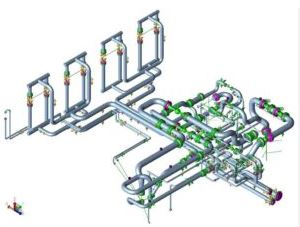
Advanced Pipe Stress Analysis Training with Caesar II | For Beginners & Engineering Professionals

Anup Kumar Dey
Owner of https://whatispiping.com/
$ 500
33 already enrolled!
Advanced course for professionals

Advanced Pipe Stress Analysis Training with Caesar II | For Beginners & Engineering Professionals
Trainers feedback
4
(19 reviews)
Anup Kumar Dey
Owner of https://whatispiping.com/
Course type
Watch to learn anytime
Course duration
1788 Min
Course start date & time
Access anytime
Language
English
This course format through pre-recorded video. You can buy and watch it to learn at any time.
Why enroll
This course is the most comprehensive pipe stress analysis course available in the market. By joining this course you will be able to learn all the basic concepts of pipe stress analysis. The participant will be able to learn the use of Caesar II software. All the examples used in Caesar II modeling and analysis are from actual projects, so you will have an actual understanding of the job that you will be performing in live projects.
Finally, by digesting the contents delivered through the modules, you will be able to improve your skill to such an extent that you will be easily employable by various reputed organizations. Also, if you are looking for a job change, the job-hunting process will be easier for you.
The course is suitable for:
Mechanical, Piping, Chemical, and Civil Engineering Graduates (Beginners)
Piping Layout Engineers seeking stress analysis skills
Project Management Professionals transitioning to piping stress roles
Construction Professionals who wants to switch jobs into piping stress domain
Please note that additional to our actual course lectures, we have added several free resources (marked as free in respective module) by other pipe stress experts to make your learning more clear and complete. Those resources may not work sometimes if anyone from those owners blocks the free access.
“Enroll today to become a proficient pipe stress engineer with hands-on Caesar II experience!”
Opportunities that awaits you!

Earn a course completion certificate
Add this credential to your LinkedIn profile, resume, or CV. Share it on social media and in your performance review
Course content
The course is readily available, allowing learners to start and complete it at their own pace.
Part A1: Pipe Stress Analysis Basics
4 Lectures
109 min
Introduction to Comprehensive Pipe Stress Analysis using Caesar II Software
Preview
10 min
What is Pipe Stress Analysis
Preview
57 min
Deciding Stress Critical Lines and Preparing Critical Line List
30 min
Inputs for Pipe Stress Analysis
12 min
Part A2: ASME B31.3 Basics
7 Lectures
102 min
Introduction-Basics of ASME B31.3 for a Piping Stress Engineer
Preview
18 min
Scopes and Exclusions
8 min
Why stress is generated in a piping system
17 min
Types of Stresses-Sustained, Occasional, Expansion
10 min
Pipe Thickness Calculation
13 min
Reinforcement Requirements
5 min
Code Equations and Allowables
31 min
Part A3: Piping Support Basics for Pipe Stress Analysis
9 Lectures
123 min
12.0 Introduction to Pipe Supports
Preview
5 min
13.0 Role of Pipe Supports in Piping Design
16 min
14.0 Types of Pipe Supports
15 min
15.0 List of Pipe Supports
29 min
16. What is the meaning of Pipe Support Spacing or Span?
11 min
17. How to Support a Pipe
16 min
18.0 Pipe Support Optimization Rules
7 min
19.0 What do you mean by Pipe Support Standard
8 min
20.0 Support Engineering Considerations
16 min
Course details
The main objective of this course is to help you upgrade your knowledge to such an extent that you can feel yourself as an advanced pipe stress engineer. This course will cover all the basic concepts, and theories, in a simple way. The course will be divided into 4 parts.
Part A will cover the basic theories that are required to analyze stress systems using software programs. This section will prepare you to work as a pipe stress engineer.
Part B will cover the static analysis methodologies of the piping system in Caesar II software. This section will explain various modeling techniques, analysis methodologies, nozzle load qualification, and other required details.
Part C will cover the dynamic analysis philosophies and explain some of the dynamic modules of Caesar II.
Part D will explain some other details that are required for becoming an advanced pipe stress engineer.
So, overall, the course will cover the maximum of the pipe stress analysis methodologies in great extent. Please be patient as the course is going to be very long as it will clear most of your doubts. Even it will prepare you for your upcoming interviews by answering some of the questions.
Part A: Basics & Fundamentals of Pipe Stress Analysis - ASME Standards & Pipe Supports
Part B: Static Pipe Stress Analysis Tutorials Using Caesar II Software
Part C: Dynamic Pipe Stress Analysis Techniques in Caesar II
Part D: Advanced Pipe Stress Analysis Topics & Specialized Techniques
Additionally, All participants will get 2-hours of doubt clearing session directly with the mentor.
Course suitable for
Oil & Gas Energy & Utilities Chemical & Pharmaceutical Piping & Layout Mechanical Chemical & Process
Key topics covered
Part A: Basics of Pipe Stress Analysis
What is Pipe Stress Analysis?
Stress Critical Line List Preparation with Practical Case Study
Inputs Required for Pipe Stress Analysis
Basics of ASME B31 3 for a Piping Stress Engineer
ASME B31.3 Scopes and Exclusions
Why stress is generated in a piping system
Types of Pipe Stresses
Pipe Thickness Calculation
Reinforcement Requirements
ASME B31.3 Code Equations and Allowables
Introduction to Pipe Supports
Role of Pipe Supports in Piping Design
Types of Pipe Supports
List of Pipe Supports
Pipe Support Span
How to Support a Pipe?
Pipe Support Optimization Rules
Pipe Support Standard
Support Engineering Considerations
What is a Piping Isometric?
What is an Expansion Loop?
Bonus Lecture: Introduction to Pipe Stress
Bonus Lecture: Pressure Stresses in Piping
Part-B: Static Analysis in Caesar II
Introduction to Caesar II
Getting Started in Caesar II
Stress Analysis of Pump Piping System
Creating Load Cases
Wind and Seismic Analysis
Generating Stress Analysis Reports
Editing Stress Analysis Model
Spring Hanger Selection and Design in Caesar II
Introduction
Types of Spring Hangers
Components of a Spring Hanger
Selection of Variable and Constant Spring hangers
Case Study of Spring Hanger Design and Selection
Certain Salient Points
Flange Leakage Analysis in Caesar II
Introduction
Types of Flange Leakage Analysis and Background Theory
Case Study-Pressure Equivalent Analysis
Case Study-NC Method
Case Study-ASME Sec VIII method
Stress Analysis of PSV Piping System
Introduction
PSV Reaction force Calculation
Applying PSV Reaction force
Practical Case Study
Certain best practices
Heat Exchanger Pipe Stress Analysis
Introduction
Creating Temperature Profile
Modeling the Heat Exchanger
Nozzle Load Qualification
Practical Case Study
Methodology for shell and tube inlet nozzle stress analysis
Vertical Tower Piping Stress Analysis
Introduction
Creating Temperature Profile
Equipment Modeling
Modeling Cleat Supports
Skirt temperature Calculation
Nozzle Load Qualification
Practical Example
Storage Tank Piping Stress Analysis
Introduction
Reason for Criticality of storage tank piping
Tank Settlement
Tank Bulging
Practical example of tank piping stress analysis
Nozzle Loading
Pump Piping Stress Analysis
API610 Pump nozzle evaluation using Caesar II
Part C: Dynamic Analysis is Caesar II
Introduction-Dynamic Analysis in Caesar II
Types of Dynamic Analysis
Static vs Dynamic Analysis
Dynamic Modal Analysis
Equivalent Static Slug Flow Analysis
Dynamic Response Spectrum Analysis
Part D: Miscellaneous other details
WRC 297/537 Calculation
What is WRC 537 and WRC 297
Inputs for WRC Calculation
WRC Calculation with Practical Example
Underground Pipe Stress Analysis
Jacketed Piping Stress Analysis
Create Unit and configuration file in CAESAR II
ASME B31J for improved Method for i, k Calculation in Caesar II
Discussion about certain Questions and Answers
GRE/FRP Pipe stress analysis
GRE Pipe Stress Analysis using Caesar II
GRE Stress Analysis-Basics
FRP Pipe Stress Analysis Case Study
GRE Flange leakage Analysis
Meaning of Stress Envelope; Understand it
Reviewing A Piping Stress System
Introduction
What to Review
Reviewing Steps
Case Study of Reviewing Pipe Stress Analysis Report
Reviewing Best Practices
FIV Study
Flow Induced Vibrations-Introduction
What is Flow Induced Vibration
Flow Induced Vibration Analysis
Corrective-Mitigation Options
AIV Study
Introduction
What is Acoustic Induced Vibration
Acoustic Induced Vibration Analysis
Corrective-Mitigation Options
2-hours of Doubt-clearing session with the mentor
Please note that additional to our actual course lectures, we have added several free resources (marked as free in respective module) by other pipe stress experts to make your learning more clear and complete. Those resources may not work sometimes if anyone from those owners blocks the free access.
Why people choose EveryEng
Industry-aligned courses, expert training, hands-on learning, recognized certifications, and job opportunities—all in a flexible and supportive environment.
- Industry Veteran
- Trainer Review

Anup Kumar Dey
Owner of https://whatispiping.com/
Questions and Answers
A: Pipe stress analysis is the process of evaluating the stresses and strains in piping systems under various loads such as pressure, temperature changes, weight, and external forces. It ensures the structural integrity and safety of the pipeline throughout its service life. This analysis helps in identifying potential failures, optimizing pipe supports, and complying with industry codes like ASME B31.3. For more detailed reading, refer to ASME guidelines and resources like https://www.asme.org/codes-standards.
A: Common loads considered include internal pressure, thermal expansion or contraction due to temperature changes, dead weight of the pipe and contents, live loads such as wind and seismic forces, and external loads like soil pressure or impact forces. Understanding these ensures the pipe's ability to withstand operational and environmental conditions without failure.
A: Material selection depends on factors like operating temperature and pressure, fluid properties (corrosiveness, toxicity), environment (corrosion, weather), and compliance with standards (ANSI, ASTM). Common materials include carbon steel, stainless steel, and alloys. Material specs usually align with codes like ASME B31.3 or API standards.
A: Isometric drawings provide a 3D view of the piping system, making it easier to visualize spatial arrangement, while orthographic drawings present multiple 2D views (top, front, side) for precise dimensions and fabrication details. Both are crucial: isometrics for installation guidance, orthographics for detailed engineering.
A: Pipe flexibility is the ability of a pipe to absorb movements or forces without excessive stress or deformation. It matters because rigid pipes under thermal expansion or external forces may crack or fail. Flexibility ensures the pipe can accommodate shifts caused by temperature changes, equipment movement, or ground settlement, enhancing durability.
A: Popular software includes CAESAR II, AutoPIPE, and PipeStress. These tools simulate piping behavior under various loads, calculate stresses, and check compliance with engineering codes. They help engineers optimize design and support placement.
A: Pipe supports are classified as rigid (like clamps, guides) and spring supports (like variable springs, constant effort supports). Their design depends on load type, pipe flexibility, movement allowance, and environmental factors. Proper support placement minimizes stress and vibration.
A: Welding affects the strength and flexibility of piping joints. Weld zones can have different mechanical properties or residual stresses, influencing overall pipe stress. Material compatibility and welding procedure specifications are critical to avoid failures.
A: Codes like ASME B31 series provide mandatory requirements for design, material selection, testing, and inspection to ensure safety and reliability. Following these standards helps in regulatory compliance and reduces risk of accidents or costly redesigns.
A: Beginners often struggle with understanding complex load cases, interpreting code requirements, selecting suitable materials, and learning analysis software. Practical experience combined with training, like attending workshops or following guides such as 'Pipe Stress Analysis Basics' by B31.3, can accelerate their proficiency.
More from Same Author
- Technical Courses
- Articles
4
Watch to learn anytime
369
9
E-Learning
Unlimited access
5
Watch to learn anytime
567
26
E-Learning
Unlimited access
4 (17)
Watch to learn anytime
740
62
E-Learning
Unlimited access
Earning and Growth option in same Industry Domain
- Pre-recorded
- Online live session
- Offline
- Articles
Watch to learn anytime
270
E-Learning
Unlimited access
Watch to learn anytime
222
E-Learning
Unlimited access
4 (19)
Watch to learn anytime
817
E-Learning
Unlimited access
More Training & Development option to expand your reach
- Technical courses
- Soft-skill courses
- Seminars & Conferences
- Articles & Blogs
Instructor led live training
528
3
Online
Live courses
November 16
30 Hrs
Advanced
Instructor led live training
28
1
Online
Live courses
November 30
1 Hrs
Beginner
Instructor led live training
254
Online
Live courses
December 27
30 Hrs
Advanced


























